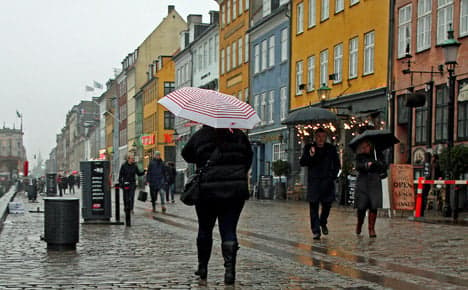A little known secret to the Danes' happiness

Plenty of theories abound about why the Danes are always near the top of happiness surveys, but The Local's opinion columnist Jessica Alexander may have a new one.
For a long time I wondered what it was about the Danes that made them always seem so contented. It couldn’t be the food, the weather or the taxes so why did they always seem so cheery? Ask a Dane how they think the weather is when it is freezing, grey and raining out and they will unwittingly answer:
“Well, it’s a good thing I’m at work.”
“Glad I am not on holiday.”
“I am looking forward to a cozy night at home tonight inside with the family.”
“There isn’t bad weather, only bad clothing.”
Try to get them to focus on anything really negative and you might be amazed at the clever twist in their language and outlook.
Having lived in several different countries now, one thing I’ve noticed is that the way we talk about life is directly related to our culture. Italians, for example, tend to be overly negative. Their baseline is to lament. Typically prone to hypochondria, they can suffer from a wide range of disturbances that vary from the cold air from air conditioners to mould in the carpets. They feel their politics and economy are a mess and they won’t get any better. True or not, the key here is that by being too negative, life can feel quite hopeless. Italians classically score low on the happiness scale despite all of that good food and wine.
Americans, on the other hand, have a tendency to express themselves in a positive way. This is a trait we are raised with as a cultural norm. Feeling good? Let’s super size that into feeling grrreat! Bubbly, happy, confident and able are all adjectives that describe a fairly standard communication style in the US.
This is perfectly fine as long as the image people portray matches up with the truth behind it, but being too confident can be dangerous.
People who are overly positive put themselves at risk by ignoring negative aspects of situations. This can shock and even depress them when they are actually faced with reality. Overly negative people, on the contrary, constantly miss the positive aspects of every situation. This brings them down in general. So where do the Danes fit in?
When doing research for ‘The Danish Way of Parenting’, my co-author and I discovered that the Danes are what psychologists would call “realistic optimists”. That is: they use reframing to view almost every aspect of life. Reframing is the ability to see the big picture and focus on the less negative aspects of a situation while not negating the negative. Let me give an example.
Imagine you are in an art gallery looking at a painting. The mood is dark and sombre. You see a mean man and a helpless woman. You conclude that the picture is negative and start to move on. But the guide stops you to point out that there are other subtle details in the picture you hadn’t even noticed. There are jovial people arriving in the background bearing gifts. The man has just hurt his foot, which is why he looks mean.The woman is being helpful, not helpless. There is a sweet child giggling in the corner and the light streaming through the window is extraordinary. In the very same picture there are many other things to focus on which change your whole experience of the picture. With practice the ability to “reframe”- to find these more positive story lines - becomes easier and the guide to finding them is you.
Reframing has been firmly linked to resilience and has now become so sought after in the US that numerous organizations are training their staff in this invaluable skill. Dean M. Becker, the founder of resilience firm Adaptive Learning Systems says: “More than education, more than experience, more than training, a person’s level of resilience will determine who succeeds and who fails. That’s true in the cancer ward, that’s true in the Olympics and that’s true in the boardroom.” Being able to reframe negative situations is a key element in resilience.
The Danes don’t have to train in reframing because it’s so engrained in their culture. They learn it from their parents and then pass it on to their own children. This ability, I believe, is one of the little known secrets to their happiness.
If a picture paints a thousand words then try to choose your words carefully. How you frame the pictures of your life could make all the difference in how you feel about it.
 Jessica Alexander is an American author who co-wrote 'The Danish Way of Parenting: A Guide to Raising the Happiest Kids in the World'. She has been married to a Dane for over 13 years and has always been fascinated by cultural differences. She speaks four languages and currently lives in Rome with her husband and two children. Her book can be purchased via Amazon and Saxo.
Jessica Alexander is an American author who co-wrote 'The Danish Way of Parenting: A Guide to Raising the Happiest Kids in the World'. She has been married to a Dane for over 13 years and has always been fascinated by cultural differences. She speaks four languages and currently lives in Rome with her husband and two children. Her book can be purchased via Amazon and Saxo.
Comments
See Also
For a long time I wondered what it was about the Danes that made them always seem so contented. It couldn’t be the food, the weather or the taxes so why did they always seem so cheery? Ask a Dane how they think the weather is when it is freezing, grey and raining out and they will unwittingly answer:
“Well, it’s a good thing I’m at work.”
“Glad I am not on holiday.”
“I am looking forward to a cozy night at home tonight inside with the family.”
“There isn’t bad weather, only bad clothing.”
Try to get them to focus on anything really negative and you might be amazed at the clever twist in their language and outlook.
Having lived in several different countries now, one thing I’ve noticed is that the way we talk about life is directly related to our culture. Italians, for example, tend to be overly negative. Their baseline is to lament. Typically prone to hypochondria, they can suffer from a wide range of disturbances that vary from the cold air from air conditioners to mould in the carpets. They feel their politics and economy are a mess and they won’t get any better. True or not, the key here is that by being too negative, life can feel quite hopeless. Italians classically score low on the happiness scale despite all of that good food and wine.
Americans, on the other hand, have a tendency to express themselves in a positive way. This is a trait we are raised with as a cultural norm. Feeling good? Let’s super size that into feeling grrreat! Bubbly, happy, confident and able are all adjectives that describe a fairly standard communication style in the US.
This is perfectly fine as long as the image people portray matches up with the truth behind it, but being too confident can be dangerous.
People who are overly positive put themselves at risk by ignoring negative aspects of situations. This can shock and even depress them when they are actually faced with reality. Overly negative people, on the contrary, constantly miss the positive aspects of every situation. This brings them down in general. So where do the Danes fit in?
When doing research for ‘The Danish Way of Parenting’, my co-author and I discovered that the Danes are what psychologists would call “realistic optimists”. That is: they use reframing to view almost every aspect of life. Reframing is the ability to see the big picture and focus on the less negative aspects of a situation while not negating the negative. Let me give an example.
Imagine you are in an art gallery looking at a painting. The mood is dark and sombre. You see a mean man and a helpless woman. You conclude that the picture is negative and start to move on. But the guide stops you to point out that there are other subtle details in the picture you hadn’t even noticed. There are jovial people arriving in the background bearing gifts. The man has just hurt his foot, which is why he looks mean.The woman is being helpful, not helpless. There is a sweet child giggling in the corner and the light streaming through the window is extraordinary. In the very same picture there are many other things to focus on which change your whole experience of the picture. With practice the ability to “reframe”- to find these more positive story lines - becomes easier and the guide to finding them is you.
Reframing has been firmly linked to resilience and has now become so sought after in the US that numerous organizations are training their staff in this invaluable skill. Dean M. Becker, the founder of resilience firm Adaptive Learning Systems says: “More than education, more than experience, more than training, a person’s level of resilience will determine who succeeds and who fails. That’s true in the cancer ward, that’s true in the Olympics and that’s true in the boardroom.” Being able to reframe negative situations is a key element in resilience.
The Danes don’t have to train in reframing because it’s so engrained in their culture. They learn it from their parents and then pass it on to their own children. This ability, I believe, is one of the little known secrets to their happiness.
If a picture paints a thousand words then try to choose your words carefully. How you frame the pictures of your life could make all the difference in how you feel about it.
 Jessica Alexander is an American author who co-wrote 'The Danish Way of Parenting: A Guide to Raising the Happiest Kids in the World'. She has been married to a Dane for over 13 years and has always been fascinated by cultural differences. She speaks four languages and currently lives in Rome with her husband and two children. Her book can be purchased via Amazon and Saxo.
Jessica Alexander is an American author who co-wrote 'The Danish Way of Parenting: A Guide to Raising the Happiest Kids in the World'. She has been married to a Dane for over 13 years and has always been fascinated by cultural differences. She speaks four languages and currently lives in Rome with her husband and two children. Her book can be purchased via Amazon and Saxo.
Join the conversation in our comments section below. Share your own views and experience and if you have a question or suggestion for our journalists then email us at [email protected].
Please keep comments civil, constructive and on topic – and make sure to read our terms of use before getting involved.
Please log in here to leave a comment.